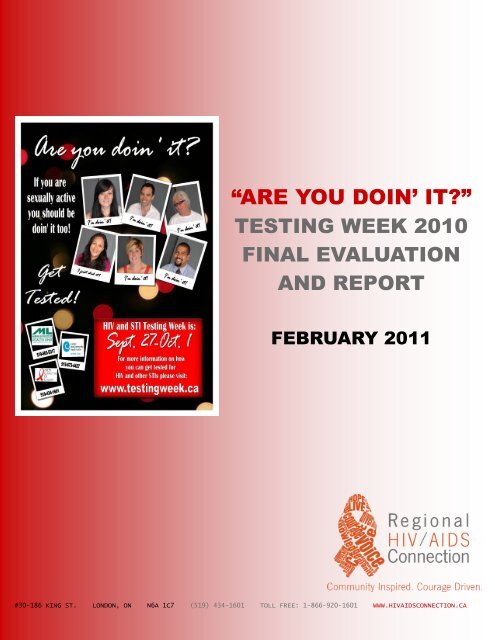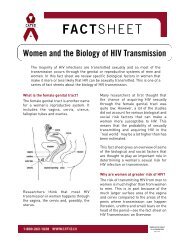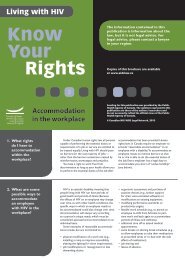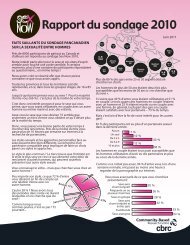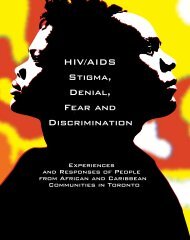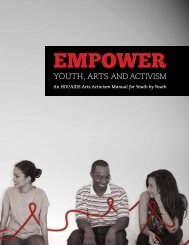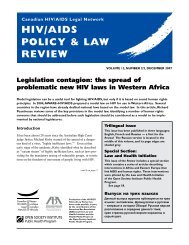âARE YOU DOIN' IT?â - Regional HIV/AIDS Connection
âARE YOU DOIN' IT?â - Regional HIV/AIDS Connection
âARE YOU DOIN' IT?â - Regional HIV/AIDS Connection
- No tags were found...
You also want an ePaper? Increase the reach of your titles
YUMPU automatically turns print PDFs into web optimized ePapers that Google loves.
“ARE <strong>YOU</strong> DOIN’ <strong>IT</strong>?”TESTING WEEK 2010FINAL EVALUATIONAND REPORTFEBRUARY 2011#30-186 KING ST. LONDON, ON N6A 1C7 (519) 434-1601 TOLL FREE: 1-866-920-1601 WWW.<strong>HIV</strong><strong>AIDS</strong>CONNECTION.CA
AcknowledgementsThe “Are you doin’ it?” would never have been a success without the efforts of volunteers,clients, colleagues and community partners — a truly perfect storm of collaboration that hasbeen the success story of the <strong>HIV</strong>/<strong>AIDS</strong> movement, this initiative included.Steve Curtis volunteered his time to help shoot, edit, produce, write music for and narrate the“Are you doin’ it?” public service announcement. Nicole Elliott, Miriam Rivera, RichardMacDonagh, Garnet Hodgins, Sarah Wood, Nick Scrivo, Trevor Hinds and Dani Gruden werethe on-air talent. Too many RHAC volunteers to count assembled and handed out thousandsof condom packs in support of the campaign, with special thanks to the indispensable FredLush for always spearheading our harm reduction material production. Jessica Ireland,Jennifer O’Brien and Andrew Rosser covered the campaign, and Owen McEwen, BrandonMiller and Matt Caron Francino were instrumental in disseminating it throughout theprovince. Deanna Holden arranged the launch event. Our community partners provided inputat every turn, many of whom operate the very testing infrastructure at the heart of thecampaign: Lyn Pierre-Pitman and Ted Town at London InterCommunity Health Centre’sOptions Clinic; Shaya Dhinsa, Lisa Kelliher, Jane Paisley-Canning, Leanne Powell, JoshuaPoynter and Erica Zarins of the Sexual Health Team at the Middlesex-London Health Unit;Bruce Rankin at the London <strong>Regional</strong> <strong>AIDS</strong> Hospice (the John Gordon Home); VeronicaBarahona at the Fanshawe Student Union; Scott Kerr and Mark Wellington at the UniversityStudents’ Council at the University of Western Ontario; Gloria Aykroyd and Brenda Done atthe Infectious Disease Care Program at St. Joseph’s Health Centre; Karen Laverty at the YouthAction Centre/Youth Opportunities Unlimited; Joseph Jillitovich at the London Cross CulturalLearner Centre; and Meredith Fraser at LUSO Community Services.Many thanks are owed at every turn for the inspired leadership of Brian Lester, Sheila Coad,Shannon Dougherty, Elizabeth Lam and Darlene Pratt.Paul Sutton, MSM <strong>HIV</strong> EducatorKevin Murphy, Gay Men’s <strong>HIV</strong> Prevention WorkerBonnie Baynham, Women’s <strong>HIV</strong>/<strong>AIDS</strong> Community Development CoordinatorMercy Nleya-Ncube, Multicultural <strong>HIV</strong> Prevention CoordinatorDaniel Pugh, Director of Education Services<strong>Regional</strong> <strong>HIV</strong>/<strong>AIDS</strong> <strong>Connection</strong>February 20112
ForewardI think we can all attest to the creative, ambitious conversations that begin around a table,perhaps gaining momentum through collective thought. Last year, the newly formedEducation team of the <strong>Regional</strong> <strong>HIV</strong>/<strong>AIDS</strong> <strong>Connection</strong> became aware of National Testing Day inJune in the US. Our team began to cultivate ideas about how effective a day like this may beto promote sexual health awareness and empowerment via informed routine <strong>HIV</strong> antibodytesting. Considering Canada does not already have a comparable event like that of oursouthern neighbor, we decided to pool our resources, up the ante, and make a whole weekdedicated to getting tested in London, Ontario (and conversely, the regions that surround/include our work).The concept, design and messages of the “Are you doin’ it?” campaign were procured in houseand fell from the minds of a very insightful and dedicated Education team. It was evident fromthe onset of the initial conversations that my team felt very confident about the success of thiscampaign. Their intuition and hard work paid off threefold. Our community partners were onboard with promotions and endorsement. By the time the week had closed, our testing unitswere reporting very high numbers. The media also appeared to jump on board of the testingbandwagon (I love the CBC!)This narrative report will provide you with a very in depth analysis of the who, what, where,when and why’s of September 27 to October 1, 2010. Should you decide to pick up thisinitiative locally, we’ve provided the tools and know-how herein.As stated in our acknowledgments, thanks to our esteemed colleagues and partners for theirsupport. Kudos and thanks to my team in Education for pulling off quite the feat. And, to Mr.Paul Sutton: cheers to your time, dedication and great skill pulling all of these fine piecestogether.We’ll see you for testing week 2011….Stay tuned!Respectfully,Daniel Pugh, Director of Education Services<strong>Regional</strong> <strong>HIV</strong>/<strong>AIDS</strong> <strong>Connection</strong>February 20113
Table of ContentsAcknowledgements 2Foreward 3Executive Summary 5Rationale 6Why testing? 6Toward a media strategy 7The PSA 7The Social Media Strategy 8Community Development 12Population-Specific Outreach 14Media Coverage 17Measurables 18Summary of Recommendations 21References 224
Executive SummaryThe “Are you doin’ it?” campaign was a multi-media strategy designed and deployed by the EducationTeam at <strong>Regional</strong> <strong>HIV</strong>/<strong>AIDS</strong> <strong>Connection</strong> (formerly the <strong>AIDS</strong> Committee of London) in support of aTesting Awareness Week, which took place between September 27 and October 1, 2010. The goal ofthe campaign was to increase the real number of <strong>HIV</strong> and STI tests occurring in London, as well asElgin, Huron, Lambton, Middlesex, Oxford, and Perth counties during this period, as well as increasingawareness for stakeholders to the importance of regular <strong>HIV</strong> and STI testing as a routine part of goodsexual health care.This is a narrative report on the development and implementation of the “Are you doin’ it?” campaignthat also includes statistical measurables about contacts accessed, educational and harm reductionmaterials distributed, real tests undertaken in London, Ontario in September 2010, and communitypartner feedback. The campaign development involved several processes: filming a public serviceannouncement (PSA), building a social media strategy, community development to maximize contactwith stakeholder groups, population specific outreach to reach stakeholder groups, working withcommunity partners to ensure sufficient testing infrastructure during Testing Awareness Week, andseeking and integrating advisory oversight from community partner groups. Each of these processesis narrated in detail within this report.The “Are you doin’ it?” campaign resulted in a statistically significant increase in the real number of<strong>HIV</strong> and STI tests carried out in London, Ontario in September 2010. The Options Clinic at the LondonInterCommunity Health Centre, the anonymous rapid point-of-care testing site in London, increasedtheir number of tests by 85% over September 2009 numbers. The Middlesex-London Health Unit sawan even more dramatic increase in testing, conducting effectively the same amount of testing for <strong>HIV</strong>and STIs in the period between September 27 and October 1 as they did from August 1—September24, 2010.Importantly, the “Are you doin’ it?” campaign was unfunded — assembled and disseminated byeducators at <strong>Regional</strong> <strong>HIV</strong>/<strong>AIDS</strong> <strong>Connection</strong> and dedicated volunteers. This report serves as a guideon how to assess the sexual health needs of various populations served by an <strong>AIDS</strong> serviceorganization (ASO) — especially an ASO that services a mixed urban and rural catchment — anddevelop a campaign that is versatile and applicable to a diverse array of stakeholders. This can bedone with the talent, dedication and leadership of ASO workers and volunteer power — which has,indeed, been the story of the <strong>HIV</strong>/<strong>AIDS</strong> movement all along.Paul Sutton, MSM <strong>HIV</strong> Educator<strong>Regional</strong> <strong>HIV</strong>/<strong>AIDS</strong> <strong>Connection</strong>February 20115
RationaleThe “Are you doin’ it?” campaign stemmed from two priorities named in the Education Services 2010-2011 program plan at <strong>Regional</strong> <strong>HIV</strong>/<strong>AIDS</strong> <strong>Connection</strong> (then the <strong>AIDS</strong> Committee of London): to integrate arts-based programming into broaderdepartmental work and to generate a multimedia public awareness campaign.Arts-based programming was prioritized as a different, often-times more meaningful way to engagewith stakeholders and target populations, bringing together volunteer power and communitycollaborators to address and express the challenge of <strong>HIV</strong>/<strong>AIDS</strong> in new ways. The multimedia publicawareness campaign was prioritized to generate more dialogue and understanding of the changingface of risk for <strong>HIV</strong> infection in London and Elgin, Huron, Lambton, Middlesex, Oxford and Perthcounties.Why testing?30% of Canadians living with <strong>HIV</strong> don’t know their status.When we were brainstorming topics and strategies that could be explored in a public awarenesscampaign undertaken by the Education Team at the <strong>Regional</strong> <strong>HIV</strong>/<strong>AIDS</strong> <strong>Connection</strong>, this statistic stoodout the most. Since 2006, modeled data has demonstrated 25-30% of Canadians living with <strong>HIV</strong> areunaware of their status (see Boulos 2006 ). And as educators mandated to work for and with specifictarget populations (namely African-Caribbean Canadians, gay, bisexual and other men who have sexwith men [MSM], women and youth at risk), we wanted to use our promotion capacity in such a waythat would disseminate information about <strong>HIV</strong>/<strong>AIDS</strong> and sexual health through general populationsnot customarily targeted by our messages while simultaneously generating useful materials tosupport the work we conduct with our target groups.Our decision to promote testing as a critical sexual health practice also supported many establishedbest practices for campaigns. Those outlined by the UK Medical Foundation for <strong>AIDS</strong> and SexualHealth were especially useful in guiding our campaign development. Most importantly, in promotingtesting, the public awareness campaign would prove to be one component of a broader circuit ofsexual health behavioural change: in producing a public service announcement and concomitantmedia campaign that encouraged people to get tested for <strong>HIV</strong> on an ongoing basis appropriate totheir sexual health needs, we would be working to connect stakeholders with multiple sources of care— from supportive agencies to informative resources to testing sites. In other words, we wereproviding information to communities in need that directly correlated with real materials that allowthem to apprehend better sexual health care. In line with these recommended standards, such acircuit supports strong, networked responses to the challenge of <strong>HIV</strong>/<strong>AIDS</strong> by bringingtogether a series of different service providers to provide better access to high quality risk6 assessment and sexual history-taking as the direct result of strengthening regular testing as anorm.
As a result, the goals of the “Are you doin’ it?” campaign were refined as follows:To increase the real number of people getting tested for<strong>HIV</strong> and STIs over the course of the campaign.To promote <strong>HIV</strong> and STI testing as a routine practice forpeople taking care of their sexual health.Toward a media strategyThe original plan for the “Are you doin’ it?” campaign was single-pronged — namely, to produce anddisseminate an awareness-building public service announcement promoting testing as a critical sexualhealth practice. Kevin Murphy conceived and storyboarded the PSA, reviewing and refining it withthe Education Team as a whole. Upon reflection, we realized we would be unable to encompass thebroader, more nuanced information about risk assessment, sexual health care, negotiated safety and<strong>HIV</strong>/STI status disclosure incumbent in testing and related sexual health practices in a PSA alone. APSA campaign on television and other channels and a matching poster campaign could work to drawattention to this information, but the Education Team identified the need for other media productionto support the campaign — namely social media. The Education Team identified the need to developa simple and easily-maintained web presence, as well as campaign-specific Facebook and Twitterprofiles. Facebook and Twitter profiles were identified as especially useful in disseminating campaigninformation amongst networks of key informants in communities in which we identified we would dodevelopment work in support of the campaign — especially student populations at the University ofWestern Ontario and Fanshawe College.The Education Team determined timelines for the media and community development strategies inmid-June. We shared preliminary plans for the campaign with the Sexual Health Team at theMiddlesex-London Health Unit in early May, and moved forward with PSA production, the socialmedia design and the community development work in late June.The PSAArmed with Kevin Murphy’s script and storyboard, the Education Team engaged the services of SteveCurtis, a dedicated volunteer at <strong>Regional</strong> <strong>HIV</strong>/<strong>AIDS</strong> <strong>Connection</strong>. Steve had extensive experience withfilming, editing and sound production — three core competencies required to supplement theEducation Team’s existing skill level in media production.The Education Team set the filming date for July 7 and arranged with our building manager to use anempty unit at 186 King St. as the filming location. Kevin Murphy and Bonnie Baynham arranged talentfor the PSA by issuing invitations to staff, volunteers and community partners. Invitations were madestrategically to best represent a race, gender, age and sexual diversity in the PSA.Filming took one day to complete. Release of Information (ROI) forms were signed and datedby all on-air talent. As due practice, these forms are housed by the Director of Educationonsite in secure files. Steve Curtis had completed a fully edited final draft along with original7
sound production in 48 hours. The availability and quality of Steve’s volunteer power was pivotallyinstrumental to the successful production of this PSA, and it has become an ongoing priority at<strong>Regional</strong> <strong>HIV</strong>/<strong>AIDS</strong> <strong>Connection</strong> to always have a volunteer recruited with such an acuity level withdigital media production.An audio version was also developed by Steve Curtis and was disseminated to student radio stations.Mercy Nleya-Ncube, Multicultural <strong>HIV</strong> Prevention Coordinator, liaised with 106.9 XFM at FanshaweCollege, and staff at the radio station produced their own take on the PSA, staging a conversationbetween a couple about the importance of testing.The PSA was very well received by staff, clients, volunteers and community partners. Were a secondversion of the PSA to be produced, we would make the following recommendations:Strive for increased diversity-representation in a futureversion of the PSA, especially with regard to transinclusion,dis/ability, and a broader racial spectrum.Translate the PSA so it is accessible to various linguisticcommunities, with a priority on French and Spanish.Especially if the “Are you doin’ it?” campaign is taken upin other geographical locations, the PSA could bereproduced to feature community and opinion leaders(political, cultural, civil society) to broaden thecampaign’s appeal.The Social Media StrategyBecause the PSA was designed to highlight the importance of testing and to provide audience appeal,it was determined early on that a comprehensive social media strategy would allow the “Are youdoin’ it?” campaign to convey comprehensive information about <strong>HIV</strong>/STI risk assessment, riskreduction, testing infrastructure and procedures, population specific prevention, poz prevention, and<strong>HIV</strong> stigma. The social media strategy allowed for the PSA itself to be disseminated through a varietyof channels not limited to traditional television broadcast.The social media strategy for the “Are you doin’ it?” campaign was carried out in three forms: via adedicated website (testingweek.ca), Facebook, and Twitter.8testingweek.caPaul Sutton developed testingweek.ca in July 2010, shortly after the PSA had been filmed andedited. The domain name, testingweek.ca, was purchased and registered for one year at
very low cost through the domain management service GoDaddy.com, and the website itself wasbuilt, hosted and managed with the free service, Tumblr. Testingweek.ca automatically blindforwardedto the website on Tumblr.Tumblr was exceedingly useful forbuilding the testingweek.cawebsite because it is a user-friendlyplatform that integrates a numberof different features, allowing awebmaster to blog, connect withFacebook and Twitter, postseparate pages with stand-aloneinformation, and receiveanonymous questions. Thewebsite was built using a freetemplate, the layout of which waseasily altered with basic HTMLlanguage to fit the campaign’sneeds. Google Analytics was usedto follow website traffic.The side-menu on the site led topages on separate topics: the“What’s my risk?” and “Making sexsafer” pages gave information on <strong>HIV</strong>/STI risk assessment and risk reduction; “What’s it like?” and“Where can I do it?” showed a video produced by the Minnesota <strong>AIDS</strong> Project that chronicled a mocktest, talked about the experience of getting tested for <strong>HIV</strong> and STIs, and provided information for localtesting sites (the Options Clinic and the Middlesex-London Health Unit); and “If I test positive?”relayed information contained in RHAC’s “Recently Diagnosed” pamphlet. “Ending <strong>HIV</strong> Stigma!”introduced stigma as an issue and demonstrated practical ways in which everyone can work to end it.This information worked to comprehensively equip seronegative or seronegative-status-assumingpeople (or <strong>HIV</strong>-negative/<strong>HIV</strong>-negative-status-assuming people) seeking testing throughout the “Areyou doin’ it?” campaign with the information they required to incorporate testing as a routine processinvolved in taking care of their sexual health. Importantly, the depth of information contained in thewebsite allowed the connection to be drawn between seronegative and seronegative-statusassumingpeople seeking testing with the testing experiences and experiences more generally ofseropositive people.The website itself was completed by late August, and throughout the month of September, storieswere blogged at least once every two days on the frontpage. Stories included several links to newsreports on various <strong>HIV</strong> issues, links to other websites that provided information and digital mediaabout <strong>HIV</strong>, and a series of testing stories solicited from people following the website. ThroughoutTesting Awareness Week (September 27-October 1), stories featured testing sites offering serviceseach day and links to media coverage for the campaign.At the end of Testing Week, a final post announced the close of the “Are you doin’ it?”campaign. The website remains online and dormant, ready to be re-activated in the case the“Are you doin’ it?” campaign is repeated. RHAC owns testingweek.ca, and the renewal fee is9
$15/year, and any other website could bebuilt and attached to testingweek.ca ifanother testing campaign varied from the“Are you doin’ it?” theme, or if thecampaign was picked up province– ornation-wide. The website remains avaluable resource with comprehensiveinformation about testing options in<strong>Regional</strong> <strong>HIV</strong>/<strong>AIDS</strong> <strong>Connection</strong>’s catchmentarea.FacebookAfter testingweek.ca was built, a Facebookpage dedicated to the “Are you doin’ it?”campaign was built. The Facebook pagewas updated with the same frequency andcontent as testingweek.ca, allowing followers to engage with content by adding comments andsending messages. The Facebook page worked to augment the community development work done insupport of the campaign: members of key communities with which RHAC educators were engaging aswell as media contacts followed the campaign on Facebook and shared key postings on their ownprofiles.With 203 total page “likes” by the end of the campaign, the “Are you doin’ it?” Facebook pageenjoyed a good following for the first version of the campaign. In subsequent versions, moredevelopment work needs to be done to broaden and increase the audience subscribing to theFacebook page in order to ensure the updates reach more people. This could be accomplished bymore and specifically-dedicated outreach in support of the campaign, as well as arranging for morecommunity partners in RHAC’s catchment area to post, profile and cover the campaign (if they happento be media partners.)TwitterA unique Twitter identity was also used during the “Are you doin’ it?” campaign , and was launchedonce the testingweek.ca website had been built. Like the Facebook page, the campaign’s Twitterupdated every time a new story appeared on the main website. Additionally, Twitter was useful inmaintaining contacts with media supporters during the campaign, considering Twitter has been soheavily integrated into all forms of news-reporting.With 55 Twitter followers (and an additional 18 via lists), a subsequent version of the “Are you doin’it?” campaign could afford to develop a more substantial following on Twitter. Twitter is an especiallygood resource for connecting online with community leaders, as well as media producers and curators.Making agreements to follow each other on Twitter with more key community and mediapartners will produce more of a domino effect with respect to our campaign updates.10
Above all, the social media strategy for the“Are you doin’ it?” campaign was verysuccessful, and there are few suggestions forfuture development: Further integrate Facebookand Twitter profiles withcommunity and media partnersto promote a widerdissemination of campaignmaterials.Bus Shelters, Postering + Other AdvertisingAfter the PSA had been produced, Kevin Murphy designed a poster for the “Are you doin’ it?”campaign based on the look and feel of the PSA itself. The poster included six still photographs takenduring PSA shooting, and were framed Polaroid-style, with the words “I’m doin’ it!” scripted at thebottom. The poster forgerounded the two key taglines from the campaign (“Are you doin’ it?” and “Ifyou are sexually active you should be doin’ it too!”) and contained the contact information for RHAC(then ACOL), MLHU and the Options Clinic, as well as a reference to the testingweek.ca website. Theposter was distributed to an extensive list of 40 multi-branch social service agencies and other publicspaces in London and our catchment area, including public libraries, student union buildings,community centres, bars, clubs and recreation facilities. Additionally, campaign materials weremailed to doctor’s offices and walk-in clinics in RHAC’s catchment area. Time was limited in carryingout some aspects of the “Are you doin’ it?” campaign, and about 25% of our distribution list did notreceive campaign material before the campaign commenced. A recommendation for a futureincarnation of the campaign would be to engage agencies and spaces on the distribution list far inadvance of the campaign, and to mobilize members of agency-wide distribution lists as well asvolunteer power in order to ensure a smooth, manageable and complete coverage across the city andcatchment area at large.RHAC purchased excess bus shelter advertising space for our annual A Taste for Live partnershipfundraisingevent in April, and when the poster was complete, the Community Relations departmentoffered the remaining bus shelter spaces for the Education Team to use during the “Are you doin’ it?”campaign. A high quality version of the poster was produced, and CBS Outdoor Marketing installedthe bus shelter poster at priority sites around London: two were placed adjacent to the University ofWestern Ontario campus (at Platts’ Lane and Western Rd. and Lambton Dr. and Western Rd.); twowere placed adjacent to Fanshawe College (at Oxford St. and Highbury Ave. and Oxford St. andFanshawe College Blvd.); and one was placed near the London InterCommunity Health Centre, thesite of the Options Clinic, in front of Police Headquarters at Dundas and Adelaide Streets. Thepresence of campaign material in the built environment added a dimension to further familiarizemembers of the public, and especially targeted populations, with the campaign itself and theimportance of testing as an important sexual health practice.RHAC purchased advertising space in Scene magazine — an independent community arts andculture tabloid — in 3 issues for $2300. Again, the advertising in Scene was a good way to11
increase awareness for the campaign and for testing as animportant sexual health practice, but the advertising cost mayprove prohibitive in future incarnations of the campaign. Similarcoverage may be secured in the future by soliciting news coveragein Scene.In summary, recommendations for future incarnations of thecampaign include:Use volunteer power and distributionnetworks to broaden posterdistribution throughout RHAC’scatchment area.Steward media partnerships togenerate in kind advertising spacedonations and solicit news coverageas alternatives to purchasingadvertising space.Use an e-blast to community partnersat the beginning of the campaign to detail easilyaccomplishable ways people can support the campaign.Community DevelopmentCommunity development in support of the “Are you doin’ it?” campaign took two forms: communityrelations and capacity assurance with already existing community partners — especially with testingsites — to ensure we had adequate, especially infrastructural, support for the campaign; secondly, wetook the “Are you doin’ it?” campaign as an opportunity to connect with post-secondary students inLondon, having chosen the end of September as Testing Week keeping college and universityorientation activities in mind.Community PartnersFirst and foremost, as a testing campaign, it was necessary to ensure local testing facilities wereinterested in having a testing campaign and could prepare for increased demand on testing serviceswere the campaign to be successful. In late June 2010, members of the Education Team heldmeetings with the Options Clinic and Middlesex-London Health Unit. Both testing sites were veryreceptive to the campaign and excited to work together on a collaborative initiative.Creative for the campaign, which was designed by RHAC, was shared with staff at the Options Clinicand MLHU as it proceeded through successive drafts in order to solicit feedback. The campaign, aswell as collaborative outreach initiatives (see Post-Secondary Youth under “Population SpecificPrevention”, p. 14) were discussed at the standing MLHU-RHAC meeting on September 8.MLHU ensured additional coverage at the Sexual Health Clinic during Testing Week; Options12 Clinic arranged extensive on-site testing at the Clinic as well as outreach. Additionally,RHAC’s <strong>HIV</strong> <strong>Regional</strong> Resource Coordinator arranged for the Options Clinic to provide testingin Woodstock on September 17 as a measure to make testing more available in RHAC’s
catchment area.A launch lunch for the “Are you doin’ it?” campaign was held at RHAC on September 10. Communitypartners were invited and the campaign creative was officially unveiled, as well as information,messaging and materials (like fact sheets, posters and condom packs) for community partners todisseminate. Representatives from the Options Clinic, the Middlesex-London Health Unit, St. Joseph’sHealth Centre’s Infections Disease Care Program, the John Gordon Home, Fanshawe Student Union,the Cross Cultural Learner Centre, and media partners (namely Rogers Television) were around thetable. At this launch event, outreach events in support of the campaign were arranged withcommunity partners.Fanshawe Student UnionIn early July, Paul Sutton was interviewed by Jessica Ireland at FSU’s The Interrobang for an article inthe paper’s “Sex Issue” set to coincide with FSU’s sexual health awareness week, which in turn,coincided with Testing Awareness Week. RHAC made contact with the VP Internal at FSU to arrangeoutreach at Fanshawe during Testing Week. Booth outreach at FSU was very successful, withapproximately 2000 condom packs distributed in 3 outreach sessions. This outreach was veryimportant as it allowed educators, testers and public health nurses from RHAC, Options and MLHU,respectively, to connect directly with new and returning students to offer education about testing andother sexual health practices at a point in the school year where the opportunity to possibility toengender new behaviour patterns was more acute.University Students’ Council (UWO)In early July, the Education Team met with the Student Life Manager and VP Campus Issues at theUSC at UWO and presented the PSA storyboard and campaign strategy. The USC was very receptive,especially considering the campaign supported the already-existing anonymous testing provisionpartnership between the USC and the Options Clinic. The USC also offered assistance in distributingcampaign resources, namely by posting campaign materials in the University Community Centre(UCC) and online, and by playing the PSA on the big screen at Orientation Week and prior toscreenings at Western Film. However, due to time restraints and <strong>IT</strong> compatibility challenges, the PSAwas not played on the screen at Orientation Week or prior to Western Film screenings. In the future,media/<strong>IT</strong> needs should be prepared far in advance with sufficient time to source solutions to logisticalissues.Other Community Development AvenuesDuring the “Are you doin’ it?” campaign, we prioritized avenues for community development,especially with post-secondary institutions, in order to maximize impact with student populations. Ina subsequent version of the campaign, the following would be other important avenues forcommunity development:Student Health Services at UWO and Fanshawe to increase testing capacity andcampaign dissemination in advance of and during Testing Awareness Week.Society of Graduate Students (SOGS) at UWO with a similar approach to communitydevelopment with the USC, aiming at campaign dissemination amongst grad students.13
Faculty Unions at UWO and Fanshawe to generate a pool of supportive instructors toencourage their students to get tested during Testing Awareness Week.Partner student groups like the UWO African Students’ Association, Spectrum Fanshawe,PrideWestern and Western Heads East for assistance in campaign dissemination andoutreach.In summary, expanded community development during a subsequent version of the “Are you doin’it?” campaign should involve:Expanded advisory consultation with community partnersduring the creative development for the campaign.Utilization of the Fanshawe Student Union’s social mediaplatform for the dissemination of campaign materials.Utilization of the big screen at the USC’s Orientation Weekand Western Film screenings for the dissemination of thePSA.Expanded community development activities with otherassociations at post-secondary campuses and additionalcommunity organizations to expand outreach and campaigndissemination in advance of Testing Awareness Week.Population Specific OutreachWhen developing a campaign at a smaller <strong>AIDS</strong> Service Organization, it is important for the campaignto be versatile and capable of being appropriately deployed in multiple population-specific outreachcontexts. The “Are you doin’ it?” campaign was developed by educators who do outreach and/orcommunity development with gay, bisexual and other men who have sex with men (MSM), women,members of African-Caribbean diasporas and, integrated into each of these outreach populations,youth at risk. As a result, the campaign was designed to have a broad appeal while working tosupport the specific <strong>HIV</strong> education and sexual health needs of our target populations.Gay, bisexual and MSMThe creative for the “Are you doin’ it?” campaign represented gay, bisexual and MSM and their sexualhealth needs in a few different ways: a gay pairing was featured in the PSA, and a mixed-race gayman’s story about getting tested and the importance of getting tested was included in the “They’redoin’ it!” portion of testingweek.ca. This creative allowed RHAC’s Gay Men’s <strong>HIV</strong> Prevention andMSM <strong>HIV</strong> Educators to refer to the PSA and web content when doing outreach and community/capacity building work with men.An “Are you doin’ it?” campaign-specific condom pack was generated and widely distributed,including in London’s bathhouse, Central Spa, and queer venues like Lavish and Brennan’s Beer Bistro.Condom outreach volunteers encouraged patrons to get tested during Testing AwarenessWeek.14Several routine outreach and community/capacity building events were modified duringSeptember 2010 to foreground the “Are you doin’ it?” campaign. Several web postings about
the campaign were made on cruising sites where RHAC conducts online outreach. The Septemberedition of the Over and Out Discussion Group for gay, bisexual and MSM made testing its primarytopic. The September edition of Bathhouse Bingo at Central Spa had all testing-related questions.The Options Clinic conducts regular testing outreach at Central Spa as well, and Options was on site atthe bathhouse during Testing Awareness Week on Monday, September 27 over the lunch hour and onThursday, September 30 from 6PM-9PM.WomenThe creative for the “Are you doin’ it?” campaign represented women in several different sociallocations and relations: the PSA showed a young women alone, an older woman alone, an intergenerationallesbian couple, and a mixed-race heterosexual couple. Additionally, the “They’re doin’it!” portion of testingweek.ca featured two women’s stories — one of a younger woman talking abouthow it is important to talk about getting tested, status and safer sex with new partners despitedecreased condom adherence amongst her peer group, and one of an older woman talking abouthow she’s still sexually relevant and that testing and safer sex are important for older people, too.These representations were important to support the emergent work of the provincial Women’s <strong>HIV</strong>/<strong>AIDS</strong> Initiative at RHAC.African-Caribbean-BlackThe creative for the “Are you doin’ it?” campaign provided limited representation of ACBcommunities that could afford to be expanded: the PSA featured a non-first generation black manand a mixed-race man, represented alone and as a part of a heterosexual couple, and as a part of agay couple, respectively. The “They’re doin’ it?” section of the website featured a story narrated bythe former man that included statistics about ACB <strong>HIV</strong> incidence and prevalence in Ontario, andexpanded on the difficulties of talking about <strong>HIV</strong> in many ACB communities. The story, however,under-represented issues of immigration and endemic <strong>HIV</strong> in countries of origin, and this should beexpanded in the creative for a future “Are you doin’ it?” campaign.Mercy Nleya-Ncube integrated the “Are you doin’ it?” campaign into regular outreach activitiesthroughout the month of September. Campaign-specific condom packs and resources weredistributed during outreach activities at the Limberlost Community Centre, Families First, the CrossCultural Learner Centre, African Pentecostal Church, and Carrefour des Femmes.At-Risk YouthThe creative for the “Are you doin’ it?” campaign did not specifically emphasize youth-specificexperiences. However, the PSA, campaign condom packs and testingweek.ca appealed to youngpeople, and most of the adolescents who saw the campaign during outreach throughout the month ofSeptember gave feedback that they really enjoyed and understood the campaign.RHAC co-organized a 4-session series of health forums at Ross Secondary School — a highschool in London that focuses exclusively on high-needs students — with junior girls, seniorgirls, junior boys and senior boys, respectively. The “Are you doin’ it?” PSA, website andcampaign materials were shown to participating students, each of whom received condom15
packs. Students enjoyed seeing the faces of RHAC staff on the condom packs and in the PSA.RHAC and the Options Clinic conducted joint outreach at the Youth Action Centre on September 27,2010. Options provided on-site rapid point-of-care testing to a number of youth the afternoon dropinwhile a RHAC educator discussed sexual health issues with youth.The “Are you doin’ it?” PSA and testingweek.ca were presented a number of times throughout themonth of September by facilitators of the Open Closet group — the LGBT youth group housed atRHAC. Open Closet youth gave positive feedback to the campaign, and facilitators led discussions ontesting and sexual health.Post-secondary aged youthOne of the main goals of the “Are you doin’ it?” campaign was to connect with and enfranchise postsecondaryaged youth, especially those attending Fanshawe College and the University of WesternOntario, into responsible safer sex, risk reduction and testingpractices appropriate to kind of sex they’re having. While thisgoal was a determining factor on the PSA and social mediastrategy’s style, educators at RHAC, in partnership with MLHUand the Options Clinic, conducted special outreach activitiestargeting this group in advance of Testing Awareness Week.Over a Friday and a Saturday evening in mid-September, RHACand MLHU partnered to conduct condom outreach (using “Areyou doin’ it?” packs) to patrons waiting in line at barsdowntown. Kevin Murphy and Paul Sutton took turns wearingMLHU’s Captain Condom costume (a character from their webbasedinteractive sexual health game “Adventures in Sex City”).The outreach teams distributed 2000 condom packs betweenthe two evenings, engaging with partygoers about safer sexoptions and testing. This mass-impact outreach activity wasimportant to punctuate the campaign while demonstrating itsrelevance at a time when partygoers may be considering sexand sexual risk taking.<strong>Regional</strong>As a separate part of her program, Jenny Gritke arranged, in partnership with the Options Clinic, theavailability of anonymous rapid point-of-care testing in Woodstock, Tillsonburg and Sarnia on threedates in September and October 2010. Although not originally conceived as part of the “Are youdoin’ it?” campaign, Paul Sutton appeared on Rogers Community Television Woodstock on September15 to promote the testing days in Oxford County. In a future version of the “Are you doin’ it?”campaign, partnering with other health units in ACOL’s catchment area and disseminatingcampaign materials through regional networks would expand the campaign’s appeal and16success.
Population-specific outreach recommendations:Ensure more ACB and multi-racial representation in thecreative (PSA, social media strategy) in a subsequentversion of the “Are you doin’ it?” campaign, especially interms of linguistic diversityEncourage more youth representation in a future “Are youdoin’ it?” PSADevelop other “Are you doin’ it?”-related resourcesspecifically directed toward youthArrange more satellite anonymous rapid point-of-caretesting outside of London and further disseminate “Are youdoin’ it?”-related resources via networks throughout ourregional catchment area.Media CoverageA press release prepared was released on Thursday, September 17, and this generated a flurry ofmedia interest about the campaign. However, ongoing contact had been maintained with selectmedia outlets prior to the campaign. Of the media that covered the campaign, early contact wasmade with Geoff Turner and Jennifer O’Brien at The London Free Press, Andrew Rosser at RogersCommunity Television London’s Daytime and Jessica Ireland at Fanshawe Student Union’sInterrobang.What follows is a summary of campaign media coverage, by type:Print Media:The London Free Press: feature coverage by Jennifer O’Brien on Wednesday, September 29th;letter to the editor by Daniel Pugh printed on Monday, September 27th.FSU Interrobang: feature coverage by Jessica Ireland in the “Sex Issue”, published Friday,September 24th.UWO Gazette: news brief published Friday, October 1st.Television: Rogers Community Television—Woodstock’s Inside Oxford: interview with Paul Sutton aboutregional testing in Woodstock and Tillsonburg on September 15th. Rogers Community Television—London’s Daytime: interview with Daniel Pugh about the “Areyou doin’ it?” campaign on September 27th. CTV’s What’s On Where?: event listing during Testing Awareness Week, September 27–October 1.17
Radio: CBC’s Ontario Morning: interview with Daniel Pugh on September 28. CHRW (UWO): interview with Mercy Nleya-Ncube on September 30; played audio PSA. 106.9 XFM (Fanshawe): performed unique version of the PSA modeling a discussion abouttesting and status disclosure, September 27-October 1.Web Listings:Thehealthline.caGay Men’s Sexual Health (GMSH) Alliance E-BlastRainbow Health Ontario event listingMeasureablesTestingLondon InterCommunity Health Centre—Options ClinicAnonymous rapid point-of-care <strong>HIV</strong> testingSeptember 2010 (total): 96August 2010 (total): 61September 2009 (total): 52September 2010First-time Testers: 33 (22 Males, 12 Females)Repeat Testers: 35 (26 Males, 9 Females)Previous Test (Not at Options): 28 (18 Males, 9 Females)Client Profile:Gay: 24 Males, 0 FemalesBisexual: 6 Males, 1 FemaleHeterosexual: 36 Males, 29 FemalesMiddlesex-London Health Unit Sexual Health ClinicConfidential <strong>HIV</strong> and STI testing18September 27-October 1, 2010Chlamydia and Gonorrhea: 207<strong>HIV</strong>: 98Hepatitis B: 85Hepatitis C: 96Syphilis: 98
August 1-September 24, 2010Chlamydia and Gonorrhea: 206<strong>HIV</strong>: 82Hepatitis B: 72Hepatitis C: 81Syphilis: 82September 1-October 30, 2009Chlamydia and Gonorrhea: 161<strong>HIV</strong>: 64Hepatitis B: 57Hepatitis C: 63Syphilis: 63Social Media Contactstestingweek.caInformation provided by Google AnalyticsSeptember 1—October 1, 2010Unique visits: 478Total pageviews (accounts for sub-pages): 1264Pages/visit: 2.64Average time on site: 2 minutes 56 secondsVisits by LocationWithin RHAC Catchment:London: 306Sarnia: 3Stratford: 3Woodstock: 3Exeter: 2Kincardine: 1St. Thomas: 1Outside RHAC Catchment:Toronto: 37Kitchener: 17Manhattan: 7Kingston: 6Windsor: 5Ottawa: 4Montréal: 2Vancouver: 2Hamilton: 2United Kingdom: 219
Facebook:Total number of ‘Likes”: 203Total number of posts: 32Raw impressions (total number of times a post is seen on the Facebook page or in a fan’sNews Feed)Maximum: 881Minimum: 299Median: 551Twitter:Total number of followers (including lists: 73Total number of posts: 33OutreachRichmond Row Outreach: 2000 condom packs (4000 condoms + 4000 lubricants + 2000information packages); ~2500 contactsRoss Secondary School Health Forums: 500 condom packs (1000 condoms + 1000 lubricants+ 500 info packages); ~500 contactsFanshawe College Booth Outreach: 800 condom packs (1600 condoms + 1600 lubricants +800 info packages); ~650 contactsNortheast St. Lawrence Church Depot Outreach: 250 condoms, 85 lubes, ~185 contactsUWO Residence Outreach (MLHU): 4 sessions, ~400 contacts, 600 condoms, 500 lubricantsCommunity Partner Feedback SurveyAgency Respondents: London InterCommunity Health Centre Options Clinic, Middlesex-LondonHealth Unit, <strong>Regional</strong> <strong>HIV</strong>/<strong>AIDS</strong> <strong>Connection</strong>, St. Joseph’s Health Centre Infections Disease CareProgramme.1. Can you describe your involvement in preparation for the “Are you doin’ it?” campaign. Also,how would you like to be involved in a future version of the “Are you doin’ it?” campaign?We were a partner with this campaign and would be interested in partnering in futurecampaignsI was not part of the process.No involvement. If it is done again, I would like to be involved in regional promotion.We were there for the launch but would have liked a little more involvement so we couldassist in preparation as well promote it more effectively.Isn't it funny, I don't remember exactly? In the early phases we met with a RHAC staff todiscuss the campaign and provide input. Then as the campaign rolled out we distributedposters/cards throughout our centre. You did a fantastic job!Was not involved in the preparation. Would be interested in helping with the next one.20
2a. Did you notice that the campaign had an impact - positive or negative?Noticed good impact/effective - 3 (50%)Noticed significant impact/significantly effective - 2 (33.3%)Not applicable - 1 (16.7%)2b. Did you see the campaign materials? How effective do you think the materials were?Noticed good impact/effective - 3 (50%)Noticed significant impact/significantly effective - 3 (50%)3. The objectives for the “Are you doin’ it campaign” were: to increase the real number of peoplegetting tested for <strong>HIV</strong> and STIs over the course of the campaign; and to promote <strong>HIV</strong> sand STItesting as a routine practice for people taking care of their sexual health. Do you think theseobjectives are relevant to health needs in London?Yes - 6 (100%)No - 0 (0%)4. The objectives for the “Are you doin’ it campaign” were: to increase the real number of peoplegetting tested for <strong>HIV</strong> and STIs over the course of the campaign; and to promote <strong>HIV</strong> sand STItesting as a routine practice for people taking care of their sexual health. Do you think theseobjectives were accomplished by the “Are you doin’ it?” campaign?Yes - 5 (83.3%)No - 1 (16.7%)Summary of RecommendationsStrive for increased diversity-representation in a future version of the PSA, especially withregard to trans-inclusion, dis/ability, and a broader racial spectrum.Translate the PSA so it is accessible to various linguistic communities, with a priority on Frenchand Spanish.Especially if the “Are you doin’ it?” campaign is taken up in other geographical locations, thePSA could be reproduced to feature community and opinion leaders (political, cultural, civilsociety) to broaden the campaign’s appeal.Further integrate Facebook and Twitter profiles with community and media partners topromote a wider dissemination of campaign materials.Use volunteer power and distribution networks to broaden poster distribution throughoutRHAC’s catchment area.Steward media partnerships to generate in kind advertising space donations and solicit newscoverage as alternatives to purchasing advertising space.Expanded advisory consultation with community partners during the creative development forthe campaign.Utilization of the big screen at the USC’s Orientation Week and Western Film screenings forthe dissemination of the PSA.Expanded community development activities with other associations at postsecondarycampuses and additional community organizations to expand outreach andcampaign dissemination in advance of Testing Awareness Week.21
Ensure more ACB and multi-racial representation in the creative (PSA, social media strategy) ina subsequent version of the “Are you doin’ it?” campaign, especially with respect to linguisticrepresentation.Encourage more youth representation in a future “Are you doin’ it?” PSADevelop other “Are you doin’ it?”-related resources specifically directed toward youthArrange more satellite anonymous rapid point-of-care testing outside of London and furtherdisseminate “Are you doin’ it?”-related resources via networks throughout our regionalcatchment area.ReferencesAndreasen, A. “Marketing Social Change: Changing Behavior to Promote Health, Social Developmentand the Environment.” San Francisco: Joosey Bass, 1995.Bloom, P.N. and W.D. Novelli. “Problems and challenges in social marketing.” J Mark 45 (1981): 79-88.Boulos, D. et al. “Estimates of <strong>HIV</strong> prevalence and incidence in Canada, 2005.” CanadaCommunicable Disease Report 32, no. 15 (2006).Epp, Jake. Achieving Health for All: A Framework for Health Promotion. Ottawa: Health and WelfareCanada, 1986.Halperin, David. What Do Gay Men Want? An Essay on Sex, Risk and Subjectivity. Ann Arbor:University of Michigan Press, 2007.Kotler, Phillip and Gerald Zaifman. “Social Marketing: An Approach to Planned Social Change.”Journal of Marketing 35 (July 1971): 3-12.Lalonde, Marc. A New Perspective on the Health of Canadians. Ottawa: Health and Welfare Canada,1974.Lefebvre, C.R. and J.A. Flora. “Social Marketing and Public Health Intervention.” Health EducationQuarterly 15 (1988): 299-315.Ling, Jack C. et al. “Social marketing: its place in public health.” Annual Review of Public Health 13(1992): 239-255.Medical Foundation for <strong>AIDS</strong> and Sexual Health. Recommended Standards for Sexual Health Services.London: Medical Foundation for <strong>AIDS</strong> and Sexual Health, 2005.Raphael, Dennis. “Grasping at straws: a recent history of health promotion in Canada.” Critical PublicHealth 18, no. 4 (2008): 438-495.Wiebe, G.D. “Merchandising Commodities and Citizenship on Television.” Public Opinion Quarterly15 (1951-1952): 679-691.22


